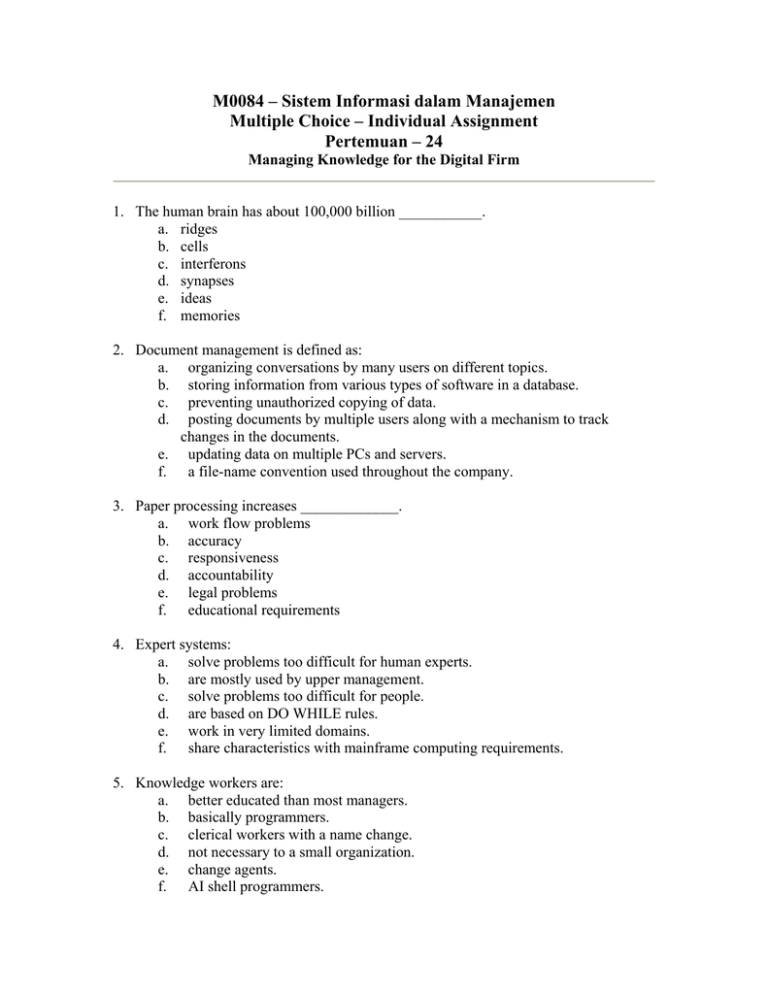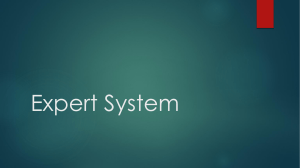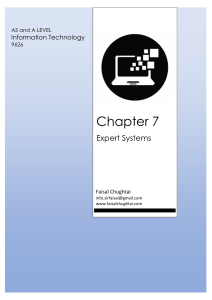M0084 – Sistem Informasi dalam Manajemen Multiple Choice – Individual Assignment
advertisement

M0084 – Sistem Informasi dalam Manajemen Multiple Choice – Individual Assignment Pertemuan – 24 Managing Knowledge for the Digital Firm 1. The human brain has about 100,000 billion ___________. a. ridges b. cells c. interferons d. synapses e. ideas f. memories 2. Document management is defined as: a. organizing conversations by many users on different topics. b. storing information from various types of software in a database. c. preventing unauthorized copying of data. d. posting documents by multiple users along with a mechanism to track changes in the documents. e. updating data on multiple PCs and servers. f. a file-name convention used throughout the company. 3. Paper processing increases _____________. a. work flow problems b. accuracy c. responsiveness d. accountability e. legal problems f. educational requirements 4. Expert systems: a. solve problems too difficult for human experts. b. are mostly used by upper management. c. solve problems too difficult for people. d. are based on DO WHILE rules. e. work in very limited domains. f. share characteristics with mainframe computing requirements. 5. Knowledge workers are: a. better educated than most managers. b. basically programmers. c. clerical workers with a name change. d. not necessary to a small organization. e. change agents. f. AI shell programmers. 6. Expert systems must be _________ before being integrated into the organization. a. brought into file size requirements b. of proven worth c. tested against known performance criteria d. adapted to the firm e. fully codified f. absolutely secure 7. Intranet technology works best as a central repository, with a/an _____________ of authors and relatively _________ information. a. large group, up-to-date b. small group, sequestered c. team, standardized d. all-employee, immediately updated e. outside consultant company, static f. small group, static 8. A problem with creating complicated expert systems is that: a. they date so quickly. b. their maintenance costs equal or exceed their development costs. c. there are no experts to set the base rules. d. expert knowledge cannot be codified for them. e. the knowledge is sequestered elsewhere. f. they do not make correct decisions because of their complicated structure. 9. It can be difficult to _____________ in organizations that encourage internal competition. a. bring in new technologies b. implement group collaboration strategies c. maintain an information hierarchy d. understand the metaconcepts of the organization e. implement managerial changes f. change corporate standards 10. An inference engine can use either: a. genetic algorithms or neural networks. b. forward or backward chaining. c. fuzzy logic or flow chains. d. peer-to-peer networks or extranets. e. natural language or robotics. f. expert systems or AI. 11. _______________ are most efficient at automating lower-level clerical functions. a. Hierarchies b. Teams c. d. e. f. New technologies Expert systems AI systems Knowledge bases 12. E-commerce bots are a form of: a. genetic engineering. b. search engine capacity. c. rule based programming. d. natural language. e. intelligent agent. f. e-mail. 13. An advantage to artificial intelligence is that _____________ is/are not part of its makeup. a. youthful mistakes b. the need to re-educate often c. continual programming changes d. time constraints e. fuzzy logic f. human feelings 14. CAD systems require: a. multiple CPUs. b. neural networks. c. processing nodes. d. powerful modeling and graphics. e. search engine capacity. f. rule-based programming. 15. In the use of ______________, the user enters information and the inference engine searches the rule base to arrive at a conclusion. a. backward chaining b. multiple searching c. fuzzy logic d. artificial intelligence e. forward chaining f. all expert systems 16. Maintaining and updating identical data on multiple PCs and servers is called: a. publishing. b. duplication. c. networking. d. peer-to-peer computing. e. replication. f. Modeling. 17. A computing system that must be trained to learn the correct solution by example is called a/an: a. hierarchical system. b. neural network. c. biological network. d. expert system. e. learning network. f. chaining system. 18. A _______________ for an expert system is set up in the form of IF/THEN statements. a. rule base b. knowledge frame c. AI shell d. information portal e. programming language f. CASE tool. 19. __________________ are conceptually based on the methods that living organisms use to evolve. a. Expert systems b. Neural networks c. Genetic algorithms d. Organic systems e. Relational databases f. If/Then statements 20. The strategy used to search through the expert system statements is called a/an/the _________________. a. knowledge frame b. programming c. knowledge base d. inference engine e. CBR f. neural network 21. The _____________ in Microsoft Office applications are intelligent agents. a. tutorials b. help screens c. menu bars d. wizards e. programs f. glossaries 22. Another term for an "adaptive computation" is: a. b. c. d. e. f. fuzzy logic. adaptive algorithm. Hybrid statement. Neural frame. Chaining algorithm. Synaptic modification.








